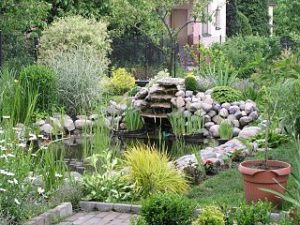The success of a pond build is derived from passion and inspiration. If you are thinking of building a water garden, do your research first by looking through landscape and garden related magazines or visiting public gardens – inspiration is usually drawn from something that has grabbed our attention resulting in a nagging urge to create a similar effect in our own garden. Being inspired is all the motivation you need to get started! From inspiration you then need to be able to visualise what it will look like in your own garden. I always suggest standing at a window on the second or third floor of your house and spend time looking out over your garden picturing exactly where you plan to site your pond, the shape and how it will blend in with the surrounding landscape.
Inspired? Now start planning your pond
- first decide what type of pond you want – either formal, natural or bog garden.
- closely observe the site you wish to build your pond and take note whether the site gets enough sunlight, whether your garden is the right size and shape for what you have in mind and what you can afford.
A formal pond can be created from a box-welded pond liner in conjunction with brick, wood, concrete and stone. It can be raised or built into the ground.
Natural pond created using flat sheet pond liner secured in place using paving or crick edging material. No matter which pond liner you decide to install, the secrete to a successful pond build is to make sure that the edges are concealed either under ground or by using edging materials such as brick or paving stone. To guarantee the life of your pond liner it must be installed above a protective underlay. If your inspiration is derived from a passion to stock fish and aquatic plants – go for a natural type pond. Build a pond as big as your garden will allow with shelves built into the sides and a sloping edge. Pond must be positioned so it gets more sun than shade.
Once you are quite clear what you want you can start putting pen to paper and do a scaled plan listing all the materials and equipment needed too. Make sure there are no underground cables or pipes on the site you intend building on.
As part of the visualisation process, take your scaled drawing and map it out in your garden using spray paint, sand or rope. Go back upstairs and look out over your garden again. Does your design work? Make any adjustments until your design matches what you had visualised. Also ask yourself if your design idea is practical for your garden size, does it work in harmony with the rest of your garden – is your plan realistic? 
Your plan also needs to include ways in which the water in your pond will be filtered and oxygenated. If you don’t want to keep any aquatic plants or just a few but want crystal clear water in your pond, you will need to install a filtration system to break down waste products and debris. Ponds need oxygen as part of maintaining a healthy ecosystem. It is important for aquatic life to thrive keeping a pond from going green and fish from dying. Oxygenating plants absorb carbon dioxide and give off oxygen therefore a great idea to stock these in a pond. An alternative is to install a fountain because moving water increases oxygen levels and therefore is healthier than stagnant water.
Choosing aquatic pond plants
- aquatic plants are chosen not only for their inherent qualities but also for their effect adding height, breadth and colour to the overall scene. They oxygenate the water, provide food and offer protection to pond creatures.
- read labels and try to imagine the effect it will have to your pond once it has grown to maturity.
- consider style of pond matched to visual impact of plant.
Inclusion of fish
When introducing fish you need to consider the mature size of the fish and the habitat you will be introducing them to. A water garden that is too small or fish that are too big will lead to problems.
The depth, average water temperature, size, moving versus still water, amount of daily sunshine versus shade – are all important factors to take into account when deciding on number and type of fish. Introduce just a few native fish to start with and see how they cope.
Pond build that will transform your garden
A pond should be the focal point of your garden and blend with the surrounding landscape. A pond build can be one that is raised off the ground constructed using concrete blocks, bricks, stone or railways sleepers. Or, a sunken pond build which will require excavating out the ground to a desired width, length and depth – with or without planting shelves. Use the removed soil to make flowerbeds or the foundation of a waterfall to flow into your pond.
If you have dreams about building your own water garden, this article provides a guide on the stages necessary to get you started. Now is a great time to make a start on your project – the ground is damp and there is just enough time to get the job done by the start of Spring.





